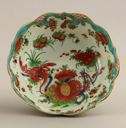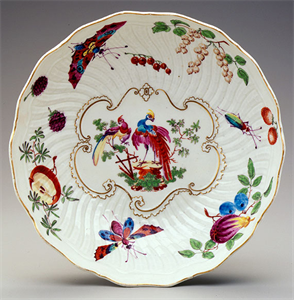
Worcester Porcelain Factory
English, born established 1751
In 1979, Montgomerians Joan and James Loeb purchased their first piece of Worcester porcelain—a blue and white gillyflower patterned plate—at a shop in Atlanta. Inspired by a lecture delivered in Montgomery by Henry Sandon, one of the world’s greatest experts on First Period Worcester, Joan Loeb enthusiastically set off to find and acquire fine examples of this colorful and well-crafted eighteenth-century English porcelain. As with most dedicated collectors, one plate only fed the appetite for more. Her quarry quickly became her passion, and, with the museum in 1990, she established a public collection and forum to educate others about the art of Worcester.
Since establishing the collection with twenty-four examples in 1990, Mr. and Mrs. Loeb added fifty-one pieces to the collection between 1991 and 2006. All of the works are on view in the decorative arts gallery, organized generally by type and ground color. They document the larger range of First Period forms and patterns, as well as examples by several of the best-known painters associated with the factory—Jefferyes Hamett O’Neal (1734—1801) and James Giles (1718—1780). In 1997, curator Elaine Gustafson authored a catalogue of the collection as it existed at that time, describing the most important pieces and summarizing the history of the Worcester factory and its products. (Visual Splendors: First Period Worcester Porcelain is available through the Museum Shop.)
First Period Worcester porcelain was made between about 1751 and 1783. It is “soft paste” porcelain that was formed and decorated by hand, rather than (as with today’s products) by machine. At the time it was created, such goods were costly and thus highly prized. Ownership ratified the social status of those who could afford to purchase them. The range of wares—from dinner to tea services, to serving pieces and decorative sculpture—suggests the importance of domestic luxury goods and particularly food-related ceremony and entertaining in European cultural history. The Loeb collection contains a number of specialty pieces such as chestnut baskets, a sweetmeat stand and a junket bowl whose purpose was to offer service of food rarely offered in modern times.
One of these specialty service pieces is the caudle cup and saucer, an excellent example of which is the beautifully decorative one given by the Loebs in 2003. The caudle cup was specifically designed (sometimes with a separate cover) to hold a medicinal drink called a posset. The tradition of the posset dates back to medieval times, when spiced alcohol (wine or other spirits) was added to heated milk to curdle it. It was used in the treatment of illnesses such as colds or fevers. Later, the drink had a thickener added in the form of cereal or egg, and the concoction was then called a caudle. In the eighteenth century, this Worcester caudle cup would have been utilized in a fine household, perhaps to offer a comforting beverage to a bedridden member of the owner’s family. The design on this cup and saucer is known as the ‘Jabberwocky’ pattern, one of dozens used during Worcester’s first period of production. The dragon-like form of the jabberwocky, along with the more formal sprays of flowers, reveal a combination of influences from the oriental style to that of the great European factories of Sevres and Meissen.
OnExhibit, Collection Spotlight, Spring, 2007
English, born established 1751
Caudle Cup
about 1765–1770
Object Type:
Ceramic
Creation Place:
Northern Europe, English, Worcestershire
Dimensions:
3 in. x 5 1/2 in. x Diam: 4 in. (7.62 cm x 13.97 cm x 10.16 cm)
Medium and Support:
Porcelain
Accession Number:
2003.0012.0001
Credit Line:
Gift of Mr. and Mrs. James Lucien Loeb
Currently On View
In 1979, Montgomerians Joan and James Loeb purchased their first piece of Worcester porcelain—a blue and white gillyflower patterned plate—at a shop in Atlanta. Inspired by a lecture delivered in Montgomery by Henry Sandon, one of the world’s greatest experts on First Period Worcester, Joan Loeb enthusiastically set off to find and acquire fine examples of this colorful and well-crafted eighteenth-century English porcelain. As with most dedicated collectors, one plate only fed the appetite for more. Her quarry quickly became her passion, and, with the museum in 1990, she established a public collection and forum to educate others about the art of Worcester.
Since establishing the collection with twenty-four examples in 1990, Mr. and Mrs. Loeb added fifty-one pieces to the collection between 1991 and 2006. All of the works are on view in the decorative arts gallery, organized generally by type and ground color. They document the larger range of First Period forms and patterns, as well as examples by several of the best-known painters associated with the factory—Jefferyes Hamett O’Neal (1734—1801) and James Giles (1718—1780). In 1997, curator Elaine Gustafson authored a catalogue of the collection as it existed at that time, describing the most important pieces and summarizing the history of the Worcester factory and its products. (Visual Splendors: First Period Worcester Porcelain is available through the Museum Shop.)
First Period Worcester porcelain was made between about 1751 and 1783. It is “soft paste” porcelain that was formed and decorated by hand, rather than (as with today’s products) by machine. At the time it was created, such goods were costly and thus highly prized. Ownership ratified the social status of those who could afford to purchase them. The range of wares—from dinner to tea services, to serving pieces and decorative sculpture—suggests the importance of domestic luxury goods and particularly food-related ceremony and entertaining in European cultural history. The Loeb collection contains a number of specialty pieces such as chestnut baskets, a sweetmeat stand and a junket bowl whose purpose was to offer service of food rarely offered in modern times.
One of these specialty service pieces is the caudle cup and saucer, an excellent example of which is the beautifully decorative one given by the Loebs in 2003. The caudle cup was specifically designed (sometimes with a separate cover) to hold a medicinal drink called a posset. The tradition of the posset dates back to medieval times, when spiced alcohol (wine or other spirits) was added to heated milk to curdle it. It was used in the treatment of illnesses such as colds or fevers. Later, the drink had a thickener added in the form of cereal or egg, and the concoction was then called a caudle. In the eighteenth century, this Worcester caudle cup would have been utilized in a fine household, perhaps to offer a comforting beverage to a bedridden member of the owner’s family. The design on this cup and saucer is known as the ‘Jabberwocky’ pattern, one of dozens used during Worcester’s first period of production. The dragon-like form of the jabberwocky, along with the more formal sprays of flowers, reveal a combination of influences from the oriental style to that of the great European factories of Sevres and Meissen.
OnExhibit, Collection Spotlight, Spring, 2007
Keywords
Click a term to view the records with the same keyword
Additional Images
Click an image to view a larger version
Related Objects
Click a record to view

Saucer
2003.0012.0002
Portfolio List
Click a portfolio name to view all the objects in that portfolio
This object is a member of the following portfolios:
Your current search criteria is: All Object records.

 by Artist (743)
by Artist (743)


